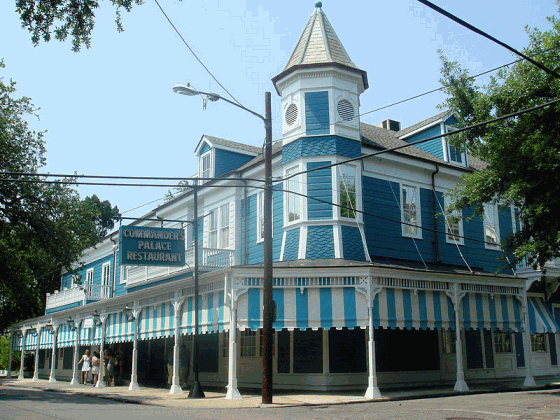|
Today in New Orleans History |
|
|
June 2


 In the 1920s,
Frank G. Giarratano was the owner of the restaurant. He lived above the restaurant with his wife, Rose and their two sons.
Fearing that the restaurant business would decline and being in declining health, Giarratano sold the restaurant to Frank
and Elinor Moran shortly after the end of World War II. In 1944, Frank and Elinor Moran bought Commander's Palace,
refurbished it and carried on its tradition of excellence with an expanded menu including many recipes still used. Thirty
years later, members of the famous Brennan restaurant family, headed by Ella Brennan, bought Commander's and redesigned the
interior to complement the outdoor setting --large windows replaced walls, and custom trellises and paintings were commissioned.
Ella encouraged innovative young cooks to add their own spin on traditional New Orleans cuisine. Chefs Paul Prudhomme
and Emeril Lagasse are two of Commander's alumni. The restaurant suffered extensive damage due to Hurricane Katrina
in 2005. After a full renovation, the restaurant re-opened on October 1, 2006. In 2001, a second Commander's Palace
restaurant was opened in the Desert Passage mall adjacent to the Aladdin, Las Vegas casino (It subsequently closed a few years
later). A Commander's Palace restaurant in Destin, Florida opened July 9, 2008, and closed in 2010. But the New Orleans flagship
Commanders remains a popular and beloved landmark (Photo by Bobak Ha'Eri. Text from WIKI)  

To receive an update for each day in New Orleans
history, join our facebook page
- Today in New Orleans History
Tweet
Victor Séjour was born in New Orleans on June 2, 1817 to a free mulatto father
from Saint-Domingue, and Eloisa Phillippe Ferrand, a free African-American octoroon born in New Orleans. His parents were
wealthy, and had him educated in a private school. At the age of nineteen he moved to Paris to continue his education and
find work. There he met members of the Parisian literary elite, including Cyrille Bisette, publisher of the black-owned journal
La Revue des Colonies. Bisette published "Le Mulâtre", Séjour's first work, in 1837. The story of
a loyal slave exacting revenge on his cruel master/father for the death of his wife, "Le Mulâtre" contains
an indictment of New World slavery that is found in none of Séjour's subsequent work. Séjour then turned
away from written fiction, and composed an ode to Napoleon in 1841 and the verse drama The Jew of Seville in 1844. The latter
cemented his reputation as a playwright; he went on to write Richard III, a Shakespeare-inspired costume drama about Richard
III of England that became his most acclaimed work. Towards the end of his life, however, Séjour's plays fell out
of favor, resulting in a decline in his status. Written in French, "Le Mulâtre" had little effect on American
literature, and was not even translated into English until the late 20th century. Its condemnation of slavery, however,
anticipates the work of later African-American writers such as Frederick Douglass and William Wells Brown. He died in Sept.
1874. (WIKI) James Pitot (1761–1831) was the second Mayor of New Orleans. Born Jacques-François Pitot
in Normandy and educated in Paris, Pitot's family was of the nobility of France, and fled that nation for the New World with
the French Revolution. At first he settled in Philadelphia, where he became an American citizen. After his arrival in New
Orleans in 1796 he prospered as a merchant and became a member of the city council. As President of the Orleans County
Police Jury (akin to a "county commission" elsewhere) when, January 31, 1814, he authorized the re-enlisting of
free people of color into the local militia. After the resignation of Etienne de Boré, Pitot was appointed Mayor
by Governor William C. C. Claiborne. He served as mayor from June 2, 1804 until July 26, 1805. During his
administration the first city charter of New Orleans was enacted. His home along Bayou St. John is listed on the National
Register of Historic Places.
On June 2, 1786, Governor Governor Miro presented to the Cabildo an "Edict
for Good Government." This edict, consisting of 34 Articles and appears to have been the first city laws issued by
the Spanish Government up to this time. Articles 24 and 25 of this edict provide definite rules governing dogs and animals
of various kinds running at large. Article 26 of the General City laws published by Miro provides that no dead animals
be thrown in the streets, but should be buried. Articles 1, 2 and 3 prohibit work, traffic of carts and selling of merchandise
on Sundays and religious Holidays. Section 27 provides that chimneys be cleaned punctually each month. Section 7 prohibits
gambling or any game of chance Section 30 of the Edict of Good Government, published by Miro at this time, required that
citizens have the fronts of their residence swept and watered. Section 29 of the Edict for Good Government published by
Miro, requires owners to keep the property in front of their homes clean, cleaning the ditches without deepening them; to
be done once a month. Article 34 of an Edict of Good Government published by Miro, prohibits the immigration of Creaole
Negroes from the French and British Islands; orders that cargoes be inspected at the “Baliza” (Belize) and if
the said Creole Negroes are found, that they be detained until their owners send them back by the first steamer; said Negroes
to be fed at owners expense, while detained. tion 17 of the General City Laws established by Governor Miro provide definite
traffic rules covering speeding on horseback or on carts in the city. (NOPL) |
|
|

To receive an update for each day in New Orleans history,
join our facebook page - Today in New
Orleans History.
Analytics |


